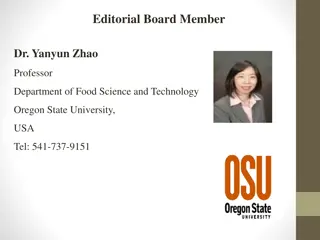
Importance of Food Fortification for Better Health
Learn about food fortification, the practice of adding essential vitamins and minerals to staple foods to enhance their nutritional value. Discover the reasons behind the need for fortification, its benefits, types, and limitations. Explore how fortification can address nutrient deficiencies and improve public health.
Download Presentation

Please find below an Image/Link to download the presentation.
The content on the website is provided AS IS for your information and personal use only. It may not be sold, licensed, or shared on other websites without obtaining consent from the author. If you encounter any issues during the download, it is possible that the publisher has removed the file from their server.
You are allowed to download the files provided on this website for personal or commercial use, subject to the condition that they are used lawfully. All files are the property of their respective owners.
The content on the website is provided AS IS for your information and personal use only. It may not be sold, licensed, or shared on other websites without obtaining consent from the author.
E N D
Presentation Transcript
StudyMafia.Org Food Fortification Submitted To: Submitted By: Studymafia.org Studymafia.org
Table Contents Definition Introduction Why Food Fortification? Benefits of Food Fortification Types of Food Fortification Limitations of Food Fortification Conclusion 2
Definition Fortification is the addition of key vitamins and minerals such as iron, iodine, zinc, Vitamin A & D to staple foods such as rice, milk and salt to improve their nutritional content. 3
Introduction Fortification is the practice of deliberately increasing the content of one or more micronutrients (i.e., vitamins and minerals) in a food or condiment to improve the nutritional quality of the food supply and provide a public health benefit with minimal risk to health. Fortified foods are those that have nutrients added to them that don't naturally occur in the food. 4
Why Food Fortification 70% of people in India do not consume enough micronutrients such as vitamins and minerals. About 70 percent of pre-school children suffer from anaemia caused by Iron Deficiency and 57 percent of preschool children have sub clinical Vitamin A deficiency. 6
Why Food Fortification Neural Tube Defects (NTDs) are the most common congenital malformation with an incidence that varies between 0.5-8/1000 births. It is estimated that 50-70% of these birth defects are preventable. One of the major causes is deficiency of Folic Acid. 7
Why Food Fortification Thus, deficiency of micronutrients or micronutrient malnutrition, also known as hidden hunger , is a serious health risk. Unfortunately, those who are economically disadvantaged do not have access to safe and nutritious food. Others either do not consume a balanced diet or lack variety in the diet because of which they do not get adequate micronutrients. 8
Why Food Fortification Often, there is considerable loss of nutrients during the processing of food. One of the strategies to address this problem is fortification of food. This method complements other ways to improve nutrition such as such as diversification of diet and supplementation of food. 9
Benefits of Food Fortification Since the nutrients are added to staple foods that are widely consumed, this is an excellent method to improve the health of a large section of the population, all at once. Fortification is a safe method of improving nutrition among people. The addition of micronutrients to food does not pose a health risk to people. 10
Benefits of Food Fortification The quantity added is so small and so well regulated as per prescribed standards that likelihood of an overdose of nutrients is unlikely. It does not require any changes in food habits and patterns of people. It is a socio- culturally acceptable way to deliver nutrients to people. 11
Benefits of Food Fortification It does not alter the characteristics of the food the taste, the feel, the look. It can be implemented quickly as well as show results in improvement of health in a relatively short period of time. This method is cost-effective especially if advantage is taken of the existing technology and delivery platforms. 12
Benefits of Food Fortification The Copenhagen Consensus estimates that every 1 Rupee spent on fortification results in 9 Rupees in benefits to the economy. It requires an initial investment to purchase both the equipment and the vitamin and mineral premix, but overall costs of fortification are extremely low. 13
Types of Food Fortification Mass fortification: In mass fortification, fortification is done in a food that are consumed by the general public. Mass fortification is considered best when majority of population has an unacceptable risk (public health risk) related to nutritional deficiency. 14
Types of Food Fortification Targeted fortification: In targeted fortification, fortification is only done in those foods that are specifically aimed at specific sub-groups of the population. Examples: complementary foods for infant and young children, foods for school feeding program. 15
Types of Food Fortification Market driven fortification: In market driven fortification, food manufacturer adopts a business-oriented initiative to add/fortify the food with certain micronutrients. Although this sort of fortification is voluntary, the manufacturer must abide by the government-set regulatory limits for fortification. 16
Types of Food Fortification Household and community fortification: Household and community fortification refer to the fortification of foods with one or more micro-nutrient at household level. This approach is also considered as a combination of supplementation and fortification. 17
Limitations of Food Fortification Food fortification may overshadow the importance of dietary diversity if it is considered as a long-term solution to micro- nutrient deficiency. These may extend from beginning up expenses and the expenses of leading preliminaries for micro-nutrient levels, physical characteristics, and taste, to a practical investigation of the acquiring intensity of the plausible recipients. 18
Limitations of Food Fortification In some foods, the shelf life of foods is reduced due to fortification. In some cases, especially in market-driven fortification, the manufacturers may fortify highly junk and relatively unhealthy foods in order to attract the consumers. 19
Conclusion Food fortification is defined as the process of deliberately adding/increasing the content of essential micro-nutrients in a food in order to improve the nutritional quality of the food. Simply, food fortification refers to the addition of micro-nutrients to the food. 21
Thanks To StudyMafia.org






















